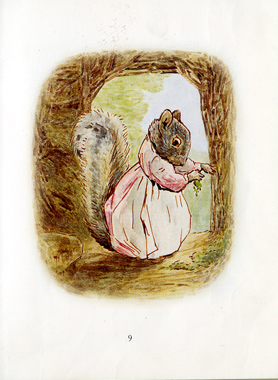First she issues a warning through the example of Squirrel Nutkin (c. 1903).
While the squirrel clan harvests nuts into their storehouses,
Then we come to Timmy Tiptoes (c. 1911).
Here Timmy Tiptoes' wife Goody Tiptoes (I'm especially fond of this squirrel illustration) prepares her home for the winter.
Timmy and Goody work hard and fast to store nuts for their hibernation. Unfortunately, some other squirrels jump to conclusions, suspecting Timmy of stealing nuts.
And they punish Timmy by dropping him into a hollowed tree, unknowingly onto his own storehouse. While Goody searches for Timmy, Timmy gorges himself on nuts, so much so that he cannot escape through the hole once Goody finds him. Eventually circumstances right themselves, and Timmy and Goody reunite.
Last, but certainly not least, we have The Tale of Ginger and Pickles (c. 1909).
This story may be enjoyed by the parents more than the children, for it holds a timely commentary on our present economic atmosphere. For you see:
Ginger and Pickles gave unlimited credit. Now the meaning of "credit" is this --
when a customer buys a bar of soap, instead of the customer pulling out a purse and
paying for it -- she says she will pay another time. (19)
Yes, friends, this synopisis' irony will be lost on the little ones. We know the outcome of the story because we're living it. But to hear it so succinctly expressed by the prophetess Beatrix Potter deserves a second glance. If we had but heeded her warning! Perhaps reading this little volume to the ones under our care will help prevent similar outcomes in their future.










These I knew :-)
ReplyDeleteLove this! Thanks
ReplyDelete